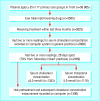Cross sectional survey of effectiveness of lipid lowering drugs in reducing serum cholesterol concentration in patients in 17 general practices
- PMID: 12663406
- PMCID: PMC152367
- DOI: 10.1136/bmj.326.7391.689
Cross sectional survey of effectiveness of lipid lowering drugs in reducing serum cholesterol concentration in patients in 17 general practices
Abstract
Objective: To compare the effectiveness of lipid lowering drugs in lowering serum cholesterol concentrations.
Design: Cross sectional study.
Setting: 17 practices within 17 primary care groups in Trent region, United Kingdom.
Participants: Patients aged 35 years or over taking lipid lowering drugs and with at least two serum cholesterol concentrations recorded on computer.
Main outcome measures: Proportion of patients achieving serum cholesterol concentration of < or =5 mmol/l and mean percentage reduction in serum cholesterol concentration.
Results: 1353 of 2469 (54.8%) patients receiving lipid lowering treatment had a last recorded serum cholesterol concentration of < or =5 mmol/l. Significantly more patients taking statins achieved the target value for serum cholesterol (5 mmol/l) than those taking fibrates (1307 (57%) v 46 (26%); P<0.0001). Atorvastatin and simvastatin were the most effective drugs in achieving the target. Significant differences were found between lipid lowering drugs for the pretreatment serum cholesterol concentration, the most recent cholesterol concentration, and the associated percentage reduction. Atorvastatin and simvastatin achieved the greatest percentage reduction in serum cholesterol concentrations (30.1%, 95% confidence interval 28.8% to 31.4%, and 28.0%, 26.7% to 29.3%, respectively). Although the mean serum cholesterol concentrations in this unselected population tended to be higher than those in clinical trials, the percentage reduction was consistent with the trials.
Conclusion: The ability of individual statins to lower serum cholesterol concentration varied, with atorvastatin and simvastatin being the most effective. The percentage reductions agreed with those of randomised controlled trials indicating likely benefits in unselected patients in primary care. As the initial serum cholesterol concentrations were higher than those in randomised controlled trials, target serum cholesterol values of < or =5 mmol/l may be unrealistic even for patients taking the most efficacious drugs. Also, the higher initial levels could mean that the absolute reduction in cardiovascular risk in primary care patients is greater than thought.
Comment in
-
Effectiveness of lipid lowering drugs in general practice: article illustrates major problem.BMJ. 2003 Jul 5;327(7405):50-1; author reply 51. doi: 10.1136/bmj.327.7405.50-b. BMJ. 2003. PMID: 12842961 Free PMC article. No abstract available.
-
Effectiveness of lipid lowering drugs in general practice: study had two major flaws.BMJ. 2003 Jul 5;327(7405):51; author reply 51. doi: 10.1136/bmj.327.7405.51. BMJ. 2003. PMID: 12842962 Free PMC article. No abstract available.
References
-
- Scandinavian Simvastatin Survival Group. Randomised trial of cholesterol lowering in 4444 patients with coronary heart disease: the Scandinavian Simvastatin Survival Study (4S) Lancet. 1994;344:1383–1389. - PubMed
-
- Long-term Intervention with Pravastatin in Ischaemic Heart Disease (LIPID) Study Group. Prevention of cardiovascular events and death with pravastatin in patients with coronary heart disease and a broad range of initial cholesterol levels. N Engl J Med. 1998;339:1349–1357. - PubMed
-
- Sacks FM, Pfeffer MA, Moye LA. The effects of pravastatin on coronary events after myocardial infarction in patients with average cholesterol levels. The CARE study. N Engl J Med. 1996;335:1001–1009. - PubMed
-
- Heart Protection Study Collaborative Group. MRC/BHF Heart Protection Study of cholesterol lowering with simvastatin in 20,536 high risk individuals: a randomised placebo-controlled trial. Lancet. 2002;360:7–22. - PubMed
-
- Department of Health. National service framework for coronary artery disease: modern standards and service models. London: Stationery Office; 2000.
Publication types
MeSH terms
Substances
LinkOut - more resources
Full Text Sources
Medical
Research Materials

